
Cooking bananas are a group of banana cultivars in the genus Musa whose fruits are generally used in cooking. They are not eaten raw and are generally starchy. Many cooking bananas are referred to as plantains or 'green bananas'. In botanical usage, the term "plantain" is used only for true plantains, while other starchy cultivars used for cooking are called "cooking bananas". True plantains are cooking cultivars belonging to the AAB group, while cooking bananas are any cooking cultivar belonging to the AAB, AAA, ABB, or BBB groups. The currently accepted scientific name for all such cultivars in these groups is Musa × paradisiaca. Fe'i bananas from the Pacific Islands are often eaten roasted or boiled, and are thus informally referred to as "mountain plantains", but they do not belong to any of the species from which all modern banana cultivars are descended.

The paprika or bell pepper is the fruit of plants in the Grossum Group of the species Capsicum annuum. Cultivars of the plant produce fruits in different colors, including red, yellow, orange, green, white, chocolate, candy cane striped, and purple. Bell peppers are sometimes grouped with less pungent chili varieties as "sweet peppers". While they are botanically fruits—classified as berries—they are commonly used as a vegetable ingredient or side dish. Other varieties of the genus Capsicum are categorized as chili peppers when they are cultivated for their pungency, including some varieties of Capsicum annuum.

Chili peppers, also spelled chile or chilli, are varieties of berry-fruit plants from the genus Capsicum, which are members of the nightshade family Solanaceae, cultivated for their pungency. Chili peppers are widely used in many cuisines as a spice to add "heat" to dishes. Capsaicin and the related capsaicinoids give chili peppers their intensity when ingested or applied topically. Chili peppers exhibit a range of heat and flavors. This diversity is the reason behind the availability of different types of chili powder, each offering its own taste and heat level.

A banana chip is a deep-fried or dried, generally crispy slice of banana. It is usually made from firmer, starchier banana varieties like the saba and Nendran cultivars. It can be sweet or savory and can be covered with sugar, honey, salt, or various spices.

The jalapeño is a medium-sized chili pepper pod type cultivar of the species Capsicum annuum. A mature jalapeño chili is 5–10 cm (2–4 in) long and 25–38 mm wide, and hangs down from the plant. The pungency of jalapeño peppers varies, but is usually between 4,000 and 8,500 units on the Scoville scale. Commonly picked and consumed while still green, it is occasionally allowed to fully ripen and turn red, orange, or yellow. It is wider and generally milder than the similar Serrano pepper.

A pimiento or pimento or cherry pepper is a variety of large, red, heart-shaped chili pepper that measures 3 to 4 in long and 2 to 3 in wide.

Rapini is a green cruciferous vegetable, with the leaves, buds, and stems all being edible; the buds somewhat resemble broccoli. Rapini is known for its bitter taste, and is particularly associated with Mediterranean cuisine. It is a particularly rich dietary source of vitamin K.
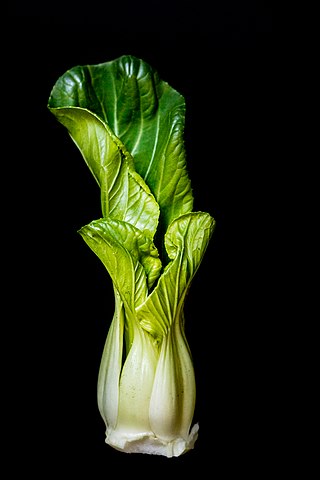
Bok choy, pak choi or pok choi is a type of Chinese cabbage cultivated as a leaf vegetable to be used as food. Varieties do not form heads and have green leaf blades with lighter bulbous bottoms instead, forming a cluster reminiscent of mustard greens. Its flavor is described as being between spinach and water chestnuts but slightly sweeter, with a mildly peppery undertone. The green leaves have a stronger flavor than the white bulb.
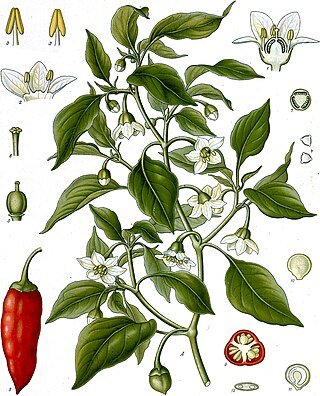
Capsicum annuum, commonly known as paprika, chili pepper, red pepper, sweet pepper, jalapeño, cayenne, or bell pepper, is a fruiting plant from the family Solanaceae (nightshades), within the genus Capsicum which is native to the northern regions of South America and to southwestern North America. The plant produces berries of many colors including red, green, and yellow, often with pungent taste. It is also one of the oldest cultivated crops, with domestication dating back to around 6,000 years ago in regions of Mexico. The genus Capsicum has over 30 species but Capsicum annuum is the primary species in its genus, as it has been widely cultivated for human consumption for a substantial amount of time and has spread across the world. This species has many uses in culinary applications, medicine, self defense, and can even be ornamental.

Green beans are young, unripe fruits of various cultivars of the common bean, although immature or young pods of the runner bean, yardlong bean, and hyacinth bean are used in a similar way. Green beans are known by many common names, including French beans, string beans, and snap beans or simply "snaps." In the Philippines, they are also known as "Baguio beans" or "habichuelas" to distinguish them from yardlong beans.

Savoy cabbage is a variety or cultivar group of the plant species Brassica oleracea. Savoy cabbage is a winter vegetable and one of several cabbage varieties. It has crinkled, emerald green leaves, which are crunchy with a slightly elastic consistency on the palate.
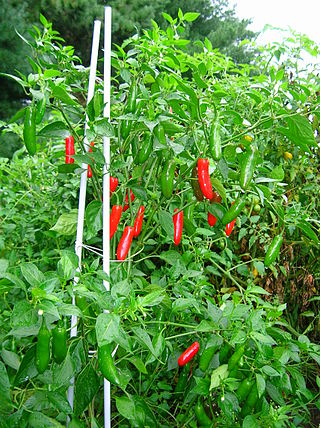
The serrano pepper is a type of chili pepper that originated in the mountainous regions of the Mexican states of Puebla and Hidalgo. The Scoville rating of the serrano pepper is 10,000 to 25,000. The name of the pepper is a reference to the mountains (sierras) of these regions. The pepper is commonly used to make hot sauces.
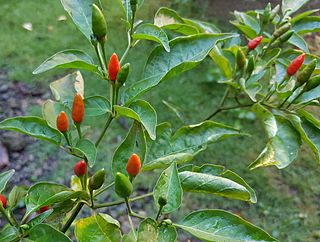
Siling labuyo is a small chili pepper cultivar that developed in the Philippines after the Columbian Exchange. It belongs to the species Capsicum frutescens and is characterized by triangular fruits that grow pointing upwards. The fruits and leaves are used in traditional Philippine cuisine. The fruit is pungent, ranking at 80,000 to 100,000 heat units in the Scoville Scale.
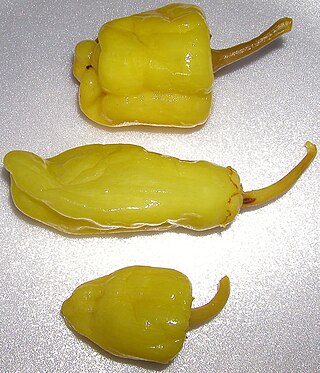
Friggitello is a sweet Italian chili pepper of the species Capsicum annuum. It is also known as the "Golden Greek pepper", "Sweet Italian pepper", or "Tuscan pepper". In the United States they may be called "pepperoncini"; they are quite distinct from Italian peperoncini, which are hot Italian chili peppers. Friggitello is mild with a slight heat and a hint of bitterness, and is sometimes pickled and sold in jars. In Italy friggitello is most associated with the region of Tuscany. The Greek variety, which is sweeter, is commonly used elsewhere in Europe and the United States.

The Fresno chile or Fresno chili pepper is a medium-sized cultivar of Capsicum annuum. It should not be confused with the Fresno Bell pepper. It is often confused with the jalapeño pepper but has thinner walls, often has milder heat, and takes less time to mature. It is, however, a Fresno County chile, which is genetically distinct from the jalapeño and it grows point up, rather than point down as with the jalapeño. The fruit starts out bright green changing to orange and red as fully matured. A mature Fresno pepper will be conical in shape, 50 mm (2 in) long, and about 25 mm (1 in) in diameter at the stem. The plants do well in warm to hot temperatures and dry climates with long sunny summer days and cool nights. They are very cold-sensitive and disease resistant, reaching a height of 60–75 cm (24–30 in).

Capsicum is a genus of flowering plants in the nightshade family Solanaceae, native to the Americas, cultivated worldwide for their edible fruit, which are generally known as "peppers" or "capsicum". Chili peppers grow on five species of Capsicum. Sweet or bell peppers and some chili peppers are Capsicum annuum, making it the most cultivated species in the genus.

Paprika is a spice made from dried and ground red peppers. It is traditionally made from Capsicum annuum varietals in the Longum group, including chili peppers. Paprika can have varying levels of heat, but the chili peppers used for hot paprika tend to be milder and have thinner flesh than those used to produce chili powder. In some languages, but not English, the word paprika also refers to the plant and the fruit from which the spice is made, as well as to peppers in the Grossum group.

The cayenne pepper is a type of Capsicum annuum. It is usually a hot chili pepper used to flavor dishes. Cayenne peppers are a group of tapering, 10 to 25 cm long, generally skinny, mostly red-colored peppers, often with a curved tip and somewhat rippled skin, which hang from the bush as opposed to growing upright. Most varieties are generally rated at 30,000 to 50,000 Scoville units.

The Habanaga is a cultivar of the chili pepper Capsicum chinense. This pepper was developed in New Mexico when a university student unintentionally crossed a Habanero and a Bhut Jolokia.




















